locallapfilt
Fast local Laplacian filtering of images
Syntax
Description
B = locallapfilt(___,Name=Value)
Examples
Import an RGB image
A = imread('peppers.png');Set parameters of the filter to increase details smaller than 0.4.
sigma = 0.4; alpha = 0.5;
Use fast local Laplacian filtering
B = locallapfilt(A, sigma, alpha);
Display the original and filtered images side-by-side.
imshowpair(A, B, 'montage')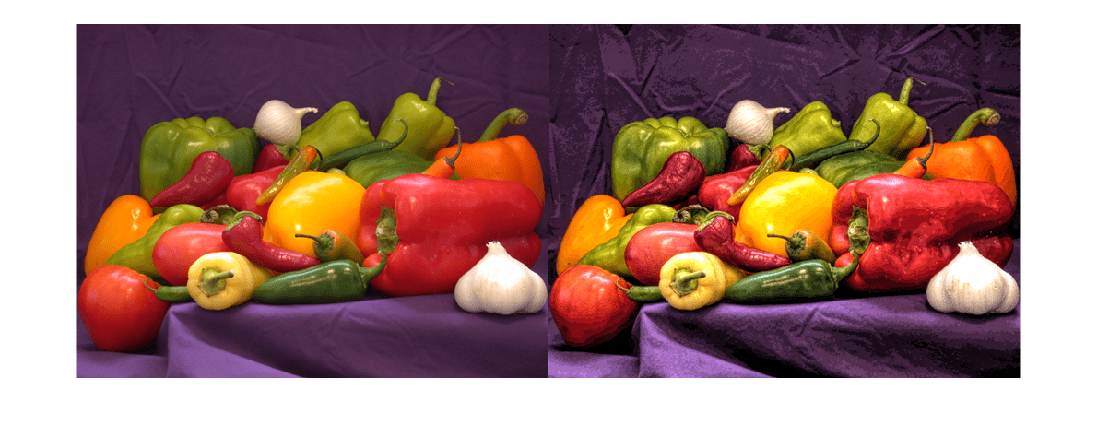
Local Laplacian filtering is a computationally intensive algorithm. To speed up processing, locallapfilt approximates the algorithm by discretizing the intensity range into a number of samples defined by the 'NumIntensityLevels' parameter. This parameter can be used to balance speed and quality.
Import an RGB image and display it.
A = imread('peppers.png'); figure imshow(A) title('Original Image')
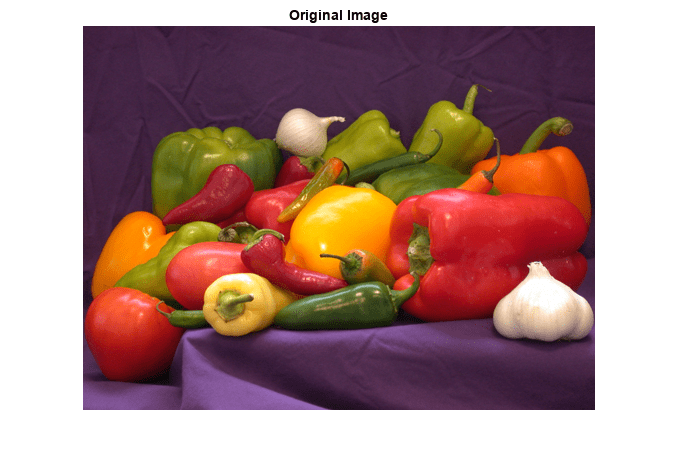
Use a sigma value to process the details and an alpha value to increase the contrast, effectively enhancing the local contrast of the image.
sigma = 0.2; alpha = 0.3;
Using fewer samples increases the execution speed, but can produce visible artifacts, especially in areas of flat contrast. Time the function using only 20 intensity levels.
t_speed = timeit(@() locallapfilt(A, sigma, alpha, 'NumIntensityLevels', 20)) t_speed = 0.0328
Now, process the image and display it.
B_speed = locallapfilt(A, sigma, alpha, 'NumIntensityLevels', 20); figure imshow(B_speed) title(['Enhanced with 20 intensity levels in ' num2str(t_speed) ' sec'])
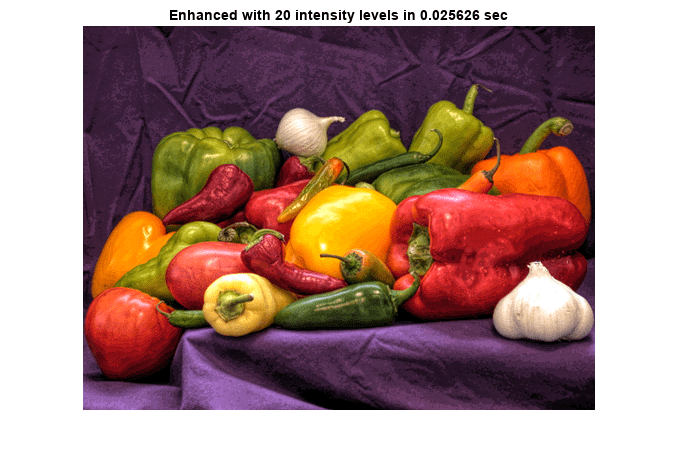
A larger number of samples yields better looking results at the expense of more processing time. Time the function using 100 intensity levels.
t_quality = timeit(@() locallapfilt(A, sigma, alpha, 'NumIntensityLevels', 100))t_quality = 0.1039
Process the image with 100 intensity levels and display it:
B_quality = locallapfilt(A, sigma, alpha, 'NumIntensityLevels', 100); figure imshow(B_quality) title(['Enhancement with 100 intensity levels in ' num2str(t_quality) ' sec'])
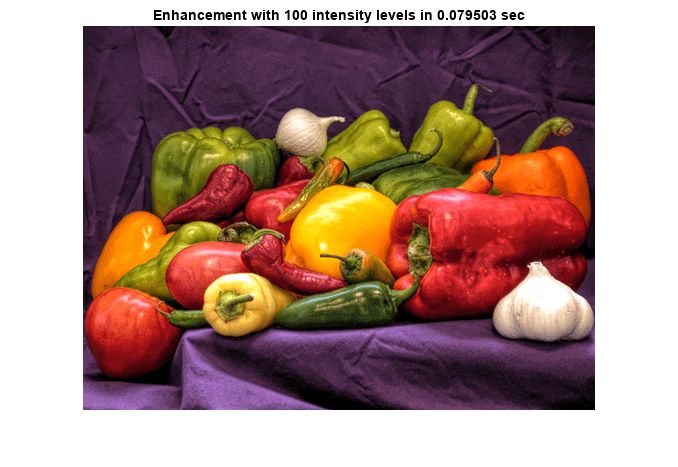
Try varying the number of intensity levels on your own images. Try also flattening the contrast (with alpha > 1). You will see that the optimal number of intensity levels is different for every image and varies with alpha. By default, locallapfilt uses a heuristic to balance speed and quality, but it cannot predict the best value for every image.
Import a color image, reduce its size, and display it.
A = imread('car2.jpg'); A = imresize(A, 0.25); figure imshow(A) title('Original Image')
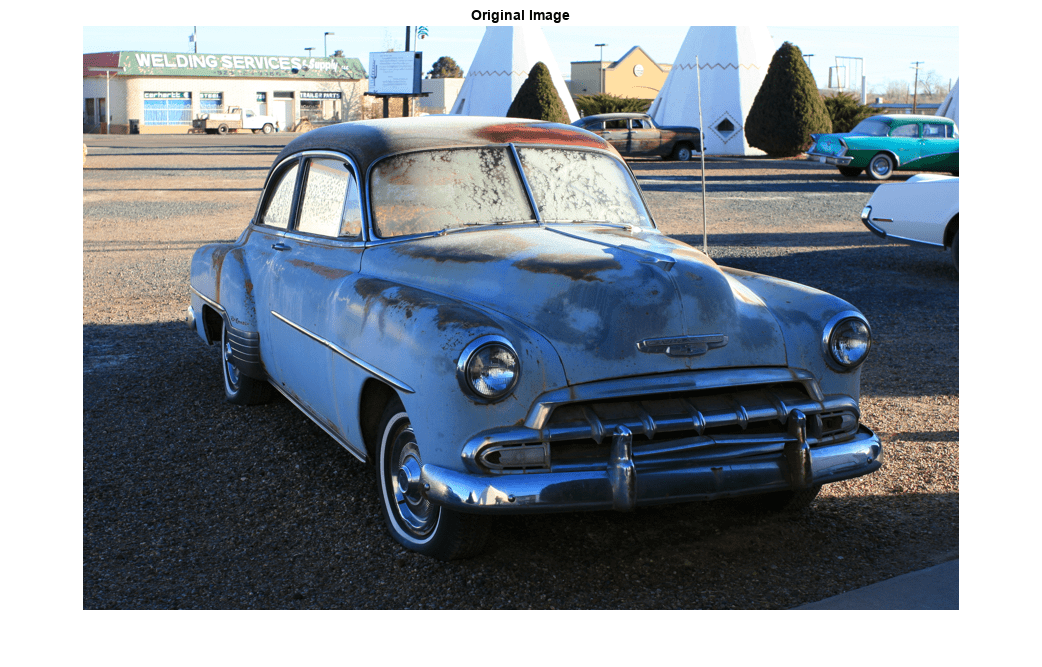
Set the parameters of the filter to dramatically increase details smaller than 0.3 (out of a normalized range of 0 to 1).
sigma = 0.3; alpha = 0.1;
Let's compare the two different modes of color filtering. Process the image by filtering its intensity and by filtering each color channel separately:
B_luminance = locallapfilt(A, sigma, alpha); B_separate = locallapfilt(A, sigma, alpha, 'ColorMode', 'separate');
Display the filtered images.
figure
imshow(B_luminance)
title('Enhanced by boosting the local luminance contrast')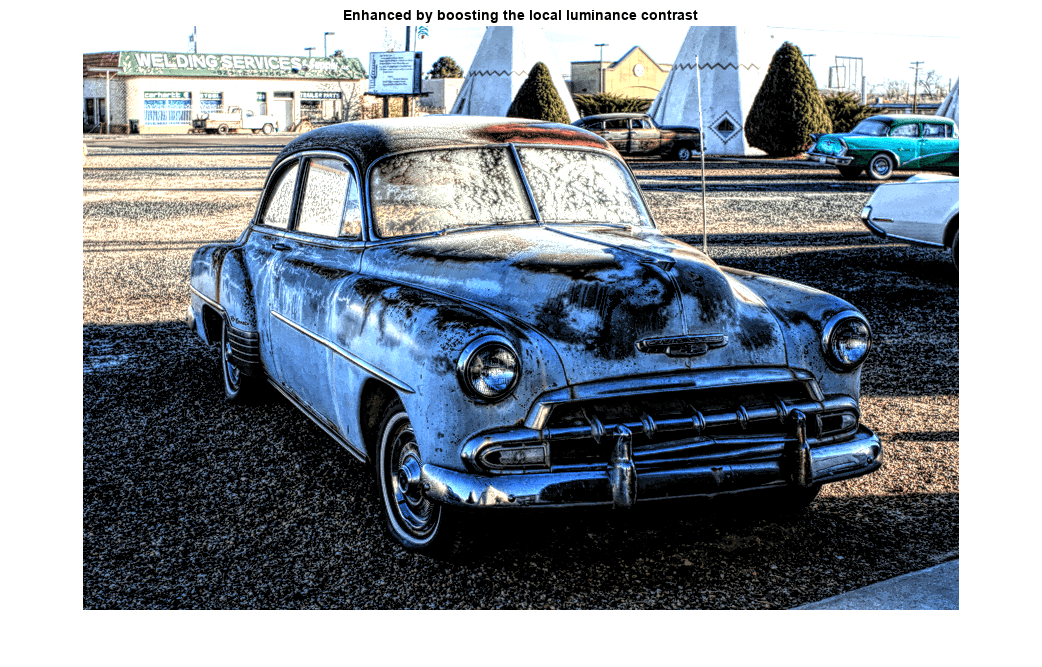
figure
imshow(B_separate)
title('Enhanced by boosting the local color contrast')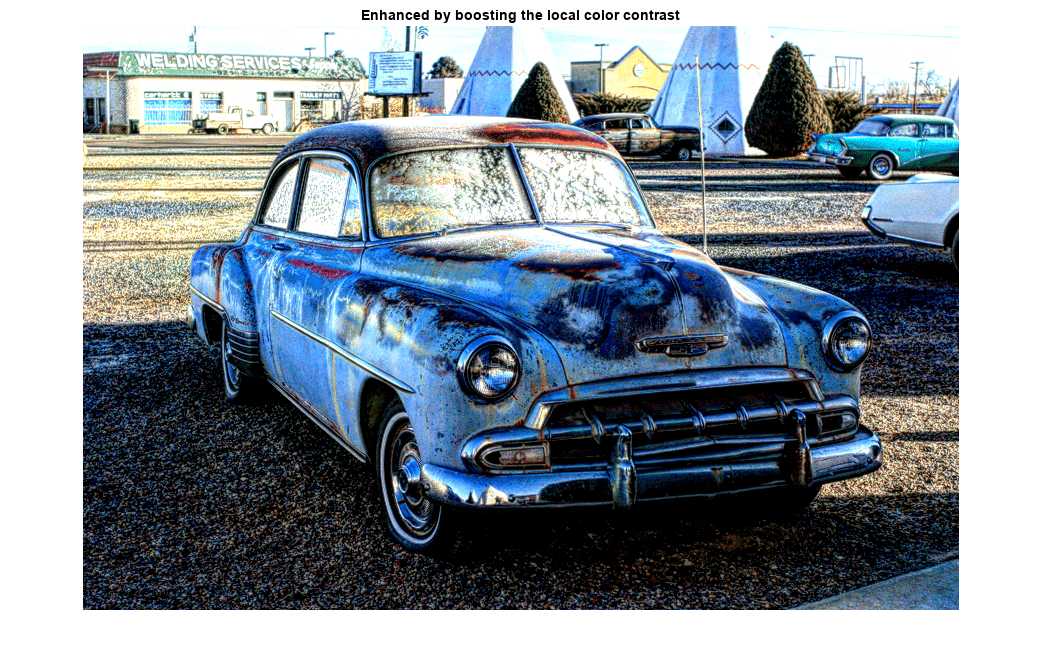
An equal amount of contrast enhancement has been applied to each image, but colors are more saturated when setting 'ColorMode' to 'separate'.
Import an image. Convert the image to floating point so that we can add artificial noise more easily.
A = imread('pout.tif');
A = im2single(A);Add Gaussian noise with zero mean and 0.001 variance.
A_noisy = imnoise(A, 'gaussian', 0, 0.001); psnr_noisy = psnr(A_noisy, A); fprintf('The peak signal-to-noise ratio of the noisy image is %0.4f\n', psnr_noisy);
The peak signal-to-noise ratio of the noisy image is 30.0234
Set the amplitude of the details to smooth, then set the amount of smoothing to apply.
sigma = 0.1; alpha = 4.0;
Apply the edge-aware filter.
B = locallapfilt(A_noisy, sigma, alpha);
psnr_denoised = psnr(B, A);
fprintf('The peak signal-to-noise ratio of the denoised image is %0.4f\n', psnr_denoised);The peak signal-to-noise ratio of the denoised image is 32.3362
Note an improvement in the PSNR of the image.
Display all three images side by side. Observe that details are smoothed and sharp intensity variations along edges are unchanged.
figure subplot(1,3,1), imshow(A), title('Original') subplot(1,3,2), imshow(A_noisy), title('Noisy') subplot(1,3,3), imshow(B), title('Denoised')
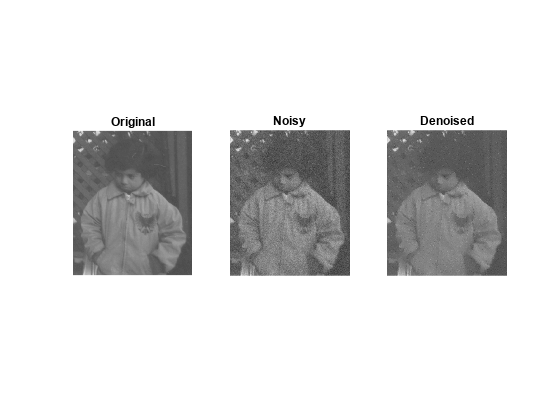
Import the image, resize it and display it
A = imread('car1.jpg'); A = imresize(A, 0.25); figure imshow(A) title('Original Image')
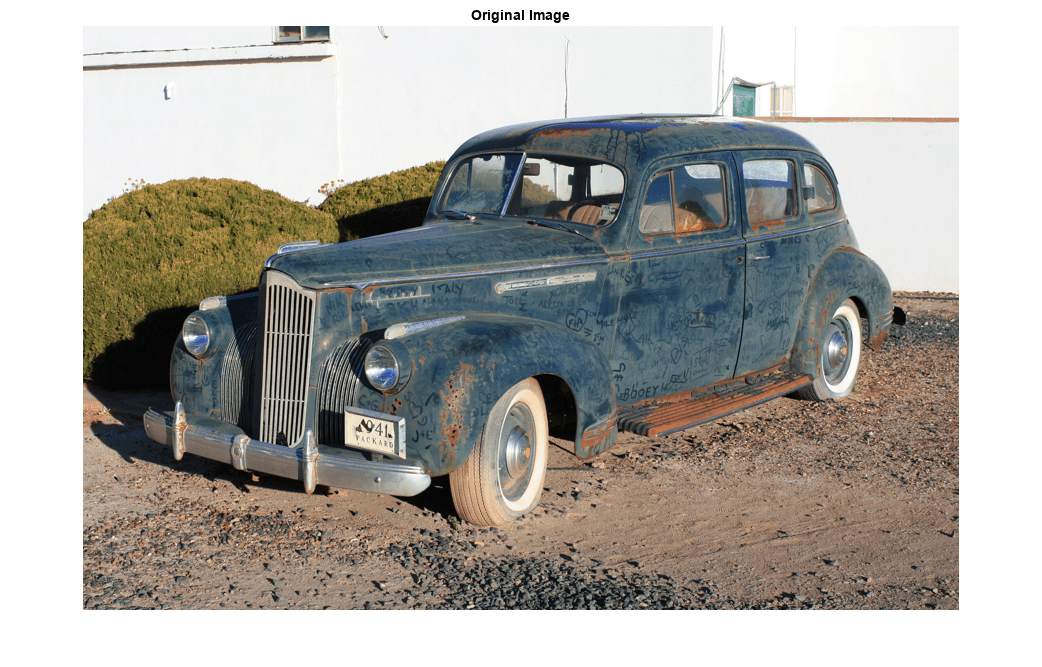
The car is dirty and covered in markings. Let's try to erase the dust and markings on the body. Set the amplitude of the details to smooth, and set a large amount of smoothing to apply.
sigma = 0.2; alpha = 5.0;
When smoothing (alpha > 1), the filter produces high quality results with a small number of intensity levels. Set a small number of intensity levels to process the image faster.
numLevels = 16;
Apply the filter.
B = locallapfilt(A, sigma, alpha, 'NumIntensityLevels', numLevels);Display the "clean" car.
figure
imshow(B)
title('After smoothing details')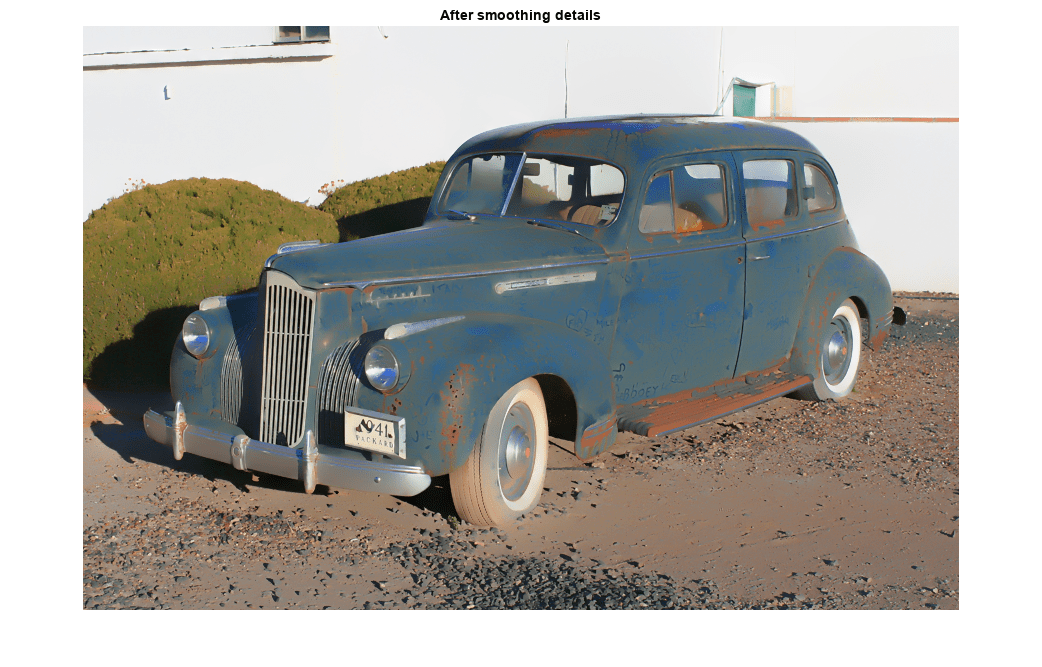
Input Arguments
Image to filter, specified as a 2-D grayscale image or 2-D RGB image.
Data Types: single | int8 | int16 | uint8 | uint16
Amplitude of edges, specified as a non-negative number. sigma should be
in the range [0, 1] for integer images and for single images defined over
the range [0, 1]. For single images defined over a different range
[a, b], sigma
should also be in the range [a,
b].
Data Types: single | double | int8 | int16 | int32 | int64 | uint8 | uint16 | uint32 | uint64
Smoothing of details, specified as a positive number. Typical values of
alpha are in the range [0.01, 10].
| Value | Description |
|---|---|
alpha less than 1 | Increases the details of the input image, effectively enhancing the local contrast of the image without affecting edges or introducing halos. |
alpha greater than 1 | Smooths details in the input image while preserving crisp edges |
alpha equal to 1 | The details of the input image are left unchanged. |
Data Types: single | double | int8 | int16 | int32 | int64 | uint8 | uint16 | uint32 | uint64
Dynamic range, specified as a non-negative number. Typical values of beta are in the range [0,
5]. beta affects the dynamic range of
A.
| Value | Description |
|---|---|
beta less than 1 | Reduces the amplitude of edges in the image, effectively compressing the dynamic range without affecting details. |
beta greater than 1 | Expands the dynamic range of the image. |
beta equal to 1 | Dynamic range of the image is left unchanged. This is the default value. |
Data Types: single | double | int8 | int16 | int32 | int64 | uint8 | uint16 | uint32 | uint64
Name-Value Arguments
Specify optional pairs of arguments as
Name1=Value1,...,NameN=ValueN, where Name is
the argument name and Value is the corresponding value.
Name-value arguments must appear after other arguments, but the order of the
pairs does not matter.
Example: B = locallapfilt(I,sigma,alpha,ColorMode="separate")
filters each color channel independently.
Before R2021a, use commas to separate each name and value, and enclose
Name in quotes.
Example: B = locallapfilt(I,sigma,alpha,"ColorMode","separate") filters each
color channel independently.
Method used to filter RGB images, specified as one of the following values. This argument has no effect on grayscale images.
| Value | Description |
|---|---|
"luminance" | locallapfilt converts the input RGB image to grayscale before filtering
and reintroduces color after filtering, which
changes the contrast of the input image without
affecting colors. |
"separate" | locallapfilt filters each color channel independently. |
Data Types: char | string
Number of intensity samples in the dynamic range of the input image,
specified as "auto" or positive integer. A higher
number of samples gives results closer to exact local Laplacian
filtering. A lower number increases the execution speed. Typical values
are in the range [10, 100]. If set to
"auto", locallapfilt chooses
the number of intensity levels automatically to balance quality and
speed based on other parameters of the filter.
Data Types: single | double | int8 | int16 | int32 | int64 | uint8 | uint16 | uint32 | uint64 | char | string
Output Arguments
Filtered image, returned as a numeric array of the same size and data type as the input image,
A.
References
[1] Paris, Sylvain, Samuel W. Hasinoff, and Jan Kautz. Local Laplacian filters: edge-aware image processing with a Laplacian pyramid, ACM Trans. Graph. 30.4 (2011): 68.
[2] Aubry, Mathieu, et al. Fast local laplacian filters: Theory and applications. ACM Transactions on Graphics (TOG) 33.5 (2014): 167.
Version History
Introduced in R2016bThe locallapfilt function shows improved performance. For
example, this code is about 6.8x faster than in the previous release.
function locallapfiltTimingTest A = imread("peppers.png"); locallapfilt(A,0.4,0.5); end
The approximate execution times are:
R2022a: 0.254 s
R2022b: 0.037 s
The code was timed on a Windows® 10, Intel®
Xeon® E5-2683 v4 CPU @ 2.10 GHz test system (two processors) using the
timeit function:
timeit(@locallapfiltTimingTest)
See Also
MATLAB Command
You clicked a link that corresponds to this MATLAB command:
Run the command by entering it in the MATLAB Command Window. Web browsers do not support MATLAB commands.
Select a Web Site
Choose a web site to get translated content where available and see local events and offers. Based on your location, we recommend that you select: .
You can also select a web site from the following list
How to Get Best Site Performance
Select the China site (in Chinese or English) for best site performance. Other MathWorks country sites are not optimized for visits from your location.
Americas
- América Latina (Español)
- Canada (English)
- United States (English)
Europe
- Belgium (English)
- Denmark (English)
- Deutschland (Deutsch)
- España (Español)
- Finland (English)
- France (Français)
- Ireland (English)
- Italia (Italiano)
- Luxembourg (English)
- Netherlands (English)
- Norway (English)
- Österreich (Deutsch)
- Portugal (English)
- Sweden (English)
- Switzerland
- United Kingdom (English)